Study of a Layered Plate Girder Element of Composite Materials and Its Applications
Abstract
:1. Introduction
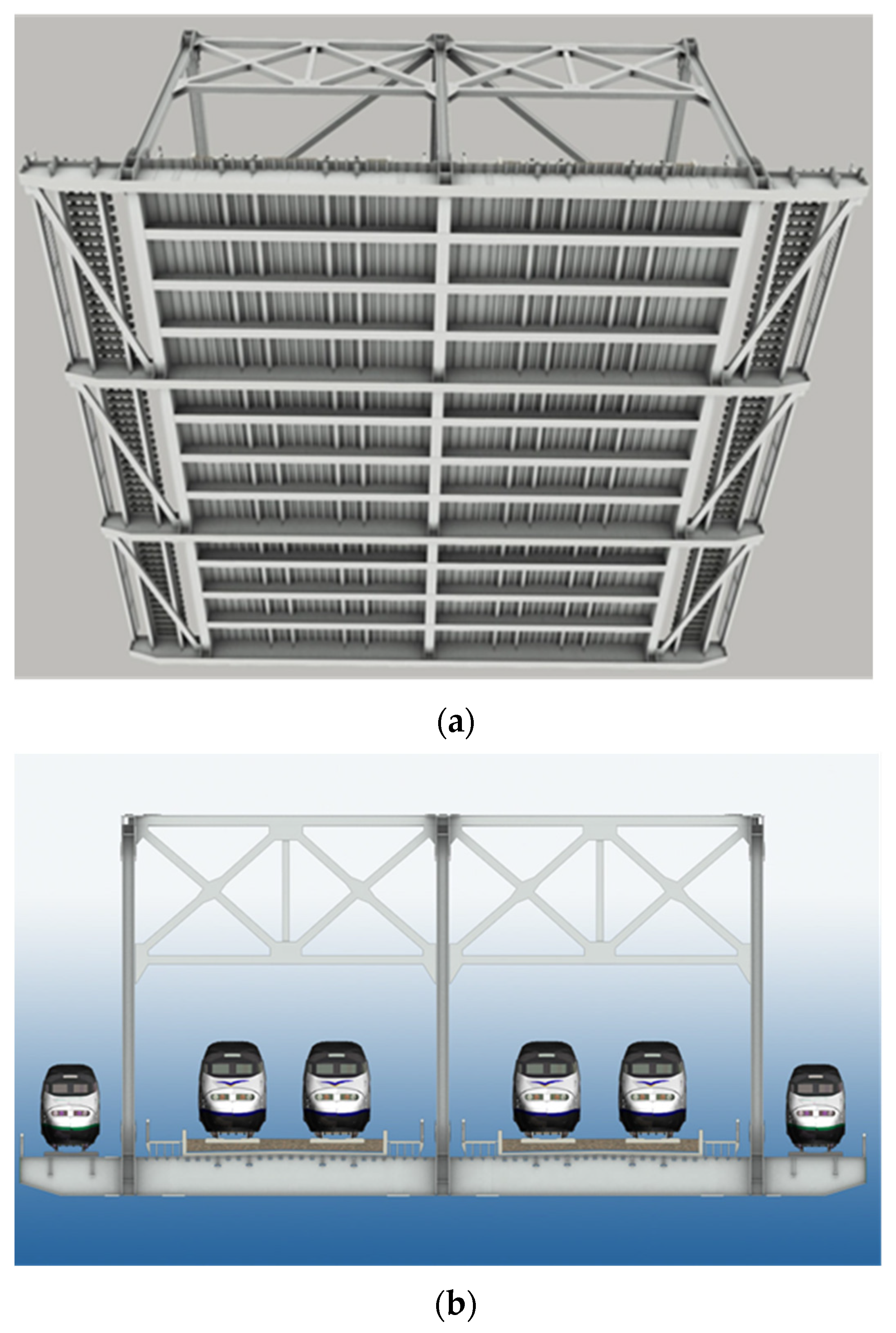
2. Layered Plate Element with Independent Interpolation of Displacements and Rotation Angles
2.1. Degree of Freedom and Displacement Pattern of Element
2.2. Stiffness Matrix for Layered Plate Element
3. LPGE Composite Action
3.1. Girder Element Constraint Matrix
- (1)
- The normal line at the base on the steel plate crossing the junction point of the girder and plate before deformation is in a straight line, and the straight line remains unchanged after deformation;
- (2)
- Before deformation, the deck including the cross-sectional area of the boundary and the section of the girder element passing through the point (including this normal line) is defined in a plane. It remains in the same plane after deformation.
3.2. LPGE Stiffness Matrix
4. Engineering Application
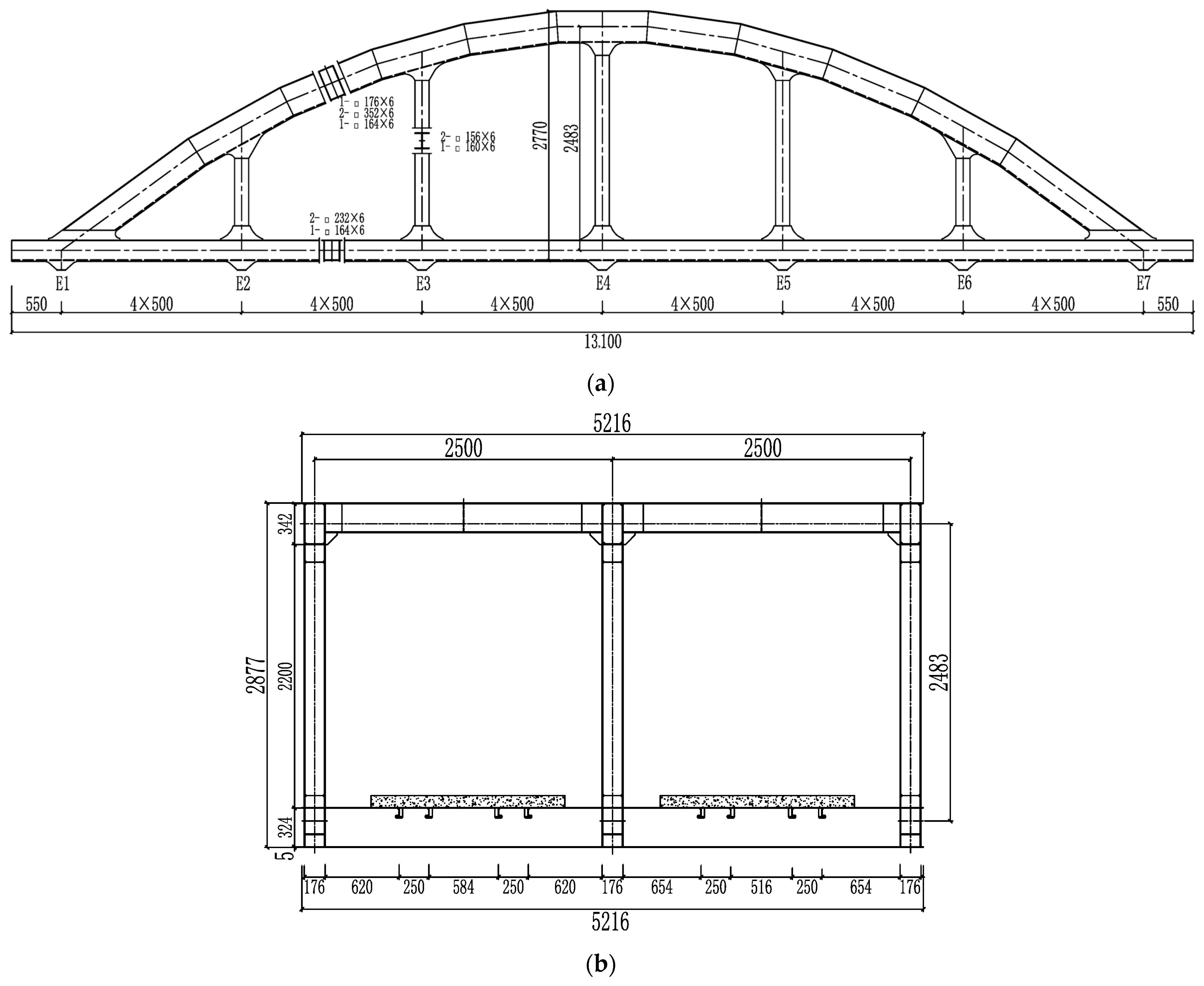
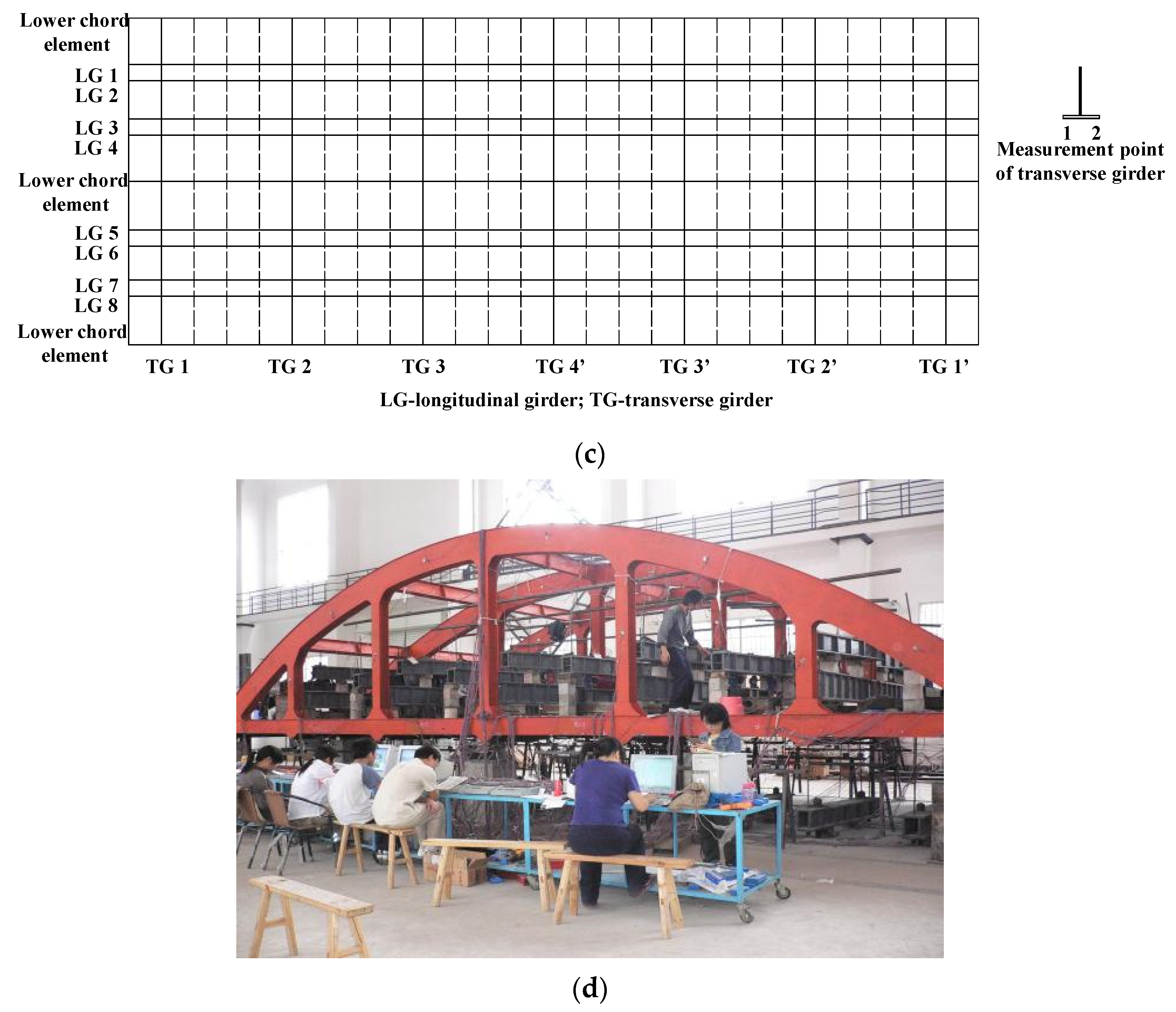
5. Conclusions
- (1)
- The LPGE combines multi-layer plates made of different materials with longitudinal and transverse girders in one element. In this way, the model is conveniently constructed with fewer elements involved, and computation is very efficient. It is particularly desirable to apply the approach to a steel–concrete composite deck structure made of one or more different building materials.
- (2)
- Compared with the ANSYS plate beam model, LPGE, as a C0-type coordinating element, ensures the deformation coordination between plates, and between plates and girders at the interface while considering the shear deformation. It provides highly accurate computation results.
- (3)
- The computation results produced by the LPGE are in good agreement with those of the ANSYS plate beam model and model test. The LPGE is proven to be an effective method, with the results obtained being more accurate.
Author Contributions
Funding
Institutional Review Board Statement
Informed Consent Statement
Data Availability Statement
Conflicts of Interest
References
- Shangguan, B.; Hu, H.Y.; Ning, P.H.; Su, Q.T. Mingzhuwan bridge: The largest span three-main-truss steel arch bridge. Struct. Eng. Int. 2023, 33, 89–95. [Google Scholar] [CrossRef]
- Qin, S.Q.; Gao, Z.Y. Developments and prospects of long-span high-speed railway bridge technologies in China. Engineering 2017, 3, 787–794. [Google Scholar] [CrossRef]
- Gao, Z.Y.; Yi, L.X.; Xiao, H.Z. Dashengguan bridge-the largest span steel arch bridge for high-speed railway. Struct. Eng. Int. 2010, 20, 299–302. [Google Scholar] [CrossRef]
- Zhao, H.W.; Ding, Y.L.; Nagarajaiah, S.; Li, A.Q. Longitudinal displacement behavior and girder end reliability of a jointless steel-truss arch railway bridge during operation. Appl. Sci. 2019, 9, 2222. [Google Scholar] [CrossRef]
- Zhang, X.M.; Wang, A.W.; Chen, W.M. Large deformation beam-slab element of eccentric stiffened plate. J. Nav. Eng. Univ. 2000, 3, 31–34. [Google Scholar]
- Wu, X.; Wu, T.T.; Chen, W.Z. Analysis of height difference between three trusses of a steel truss bridge during incremental launching. Stahlbau 2018, 87, 910–922. [Google Scholar] [CrossRef]
- Tan, Y.L.; Zhu, B.; Yan, T.Y.; Huang, B.; Wang, X.W.; Yang, W.W.; Huang, B. Experimental study of the mechanical behavior of the steel-concrete joints in a composite truss bridge. Appl. Sci. 2019, 9, 854. [Google Scholar] [CrossRef]
- Hou, W.Q.; Ye, M.X. Design methods of headed studs for composite decks of through steel bridges in high-speed railway. J. Cent. South Univ. Technol. 2011, 18, 946–952. [Google Scholar] [CrossRef]
- Han, Y.Q.; Ye, M.X. Mechanical characteristics of three-truss plate-truss composite bridges on high-speed railways. Appl. Mech. Mater. 2014, 590, 358–362. [Google Scholar] [CrossRef]
- Chen, K.L.; Wang, R.H.; Huang, Y.H.; Cai, L.R. Study on spatial calculation method of three-girder continuous slab-truss composite bridge. Civ. Eng. Environ. Eng. 2011, 33, 32–37. [Google Scholar]
- Zeng, Y.; Zheng, H.J.; Jiang, Y.H.; Ran, J.H.; He, X. Modal analysis of a steel truss girder cable-stayed bridge with single tower and single cable plane. Appl. Sci. 2022, 12, 7627. [Google Scholar] [CrossRef]
- Xing, Y.H.; Wang, W.Y.; Ou, Y.; Jiang, X.C.; Al-azzani, H. Seismic behavior of steel truss and concrete composite shear wall with double x-shaped braces. J. Build. Eng. 2022, 62, 105399. [Google Scholar] [CrossRef]
- Han, J.H.; Shu, G.P.; Qin, Y.; Zhou, G.G.; Zhou, X.L. Experimental seismic behavior of double skin composite wall with steel truss. J. Constr. Steel Res. 2021, 180, 106569. [Google Scholar] [CrossRef]
- Kaminski, M.; Błonski, R. Analytical and numerical reliability analysis of certain pratt steel truss. Appl. Sci. 2022, 12, 2901. [Google Scholar] [CrossRef]
- Kumar, Y.V.S.; Mukhopadhyay, M. Finite element analysis of ship structures using a new stiffened plate element. Appl. Ocean. Res. 2000, 22, 361–374. [Google Scholar] [CrossRef]
- Jaksic, N.; Greuner, H.; Herrmann, A. Fem investigation and thermo-mechanic tests of the new solid tungsten divertor tile for asdex upgrade. Fusion Eng. Des. 2013, 88, 1789–1792. [Google Scholar] [CrossRef]
- Chen, Y.J.; Sun, H.L.; Feng, Z.F. Study on seismic isolation of long span double deck steel truss continuous girder bridge. Appl. Sci. 2022, 12, 2567. [Google Scholar] [CrossRef]
- Innocenzi, R.D.; Nicoletti, V.; Arezzo, D.; Carbonari, S.; Gara, F.; Dezi, L. A Good Practice for the Proof Testing of Cable-Stayed Bridges. Appl. Sci. 2022, 12, 3547. [Google Scholar] [CrossRef]
- Nicoletti, V.; Arezzo, D.; Carbonari, S.; Dezi, F.; Gara, F. Measurements of ambient vibrations for a cable-stayed bridge including the soil-foundation system. In Proceedings of the 11th International Conference on Structural Dynamics, EURODYN, Athens, Greece, 23–26 November 2020; Volume 1, pp. 1722–1730. [Google Scholar]
- Zhu, Q.; Wang, H.; Zhu, X.; Spencer, B.F., Jr. Investigation on the pattern for train-induced strains of the long-span steel truss railway bridge. Eng. Struct. 2022, 275, 115268. [Google Scholar] [CrossRef]
- Cheng, J.; Xu, M.S.; Xu, H. Mechanical performance study and parametric analysis of three-tower four-span suspension bridges with steel truss girders. Steel Compos. Struct. 2019, 32, 189–198. [Google Scholar]
- Xu, Y.; Zeng, Z.; Wang, Z.; Yan, H. Seismic study of a widened and reconstructed long-span continuous steel truss bridge. Struct. Infrastruct. Eng. 2020, 17, 191–201. [Google Scholar] [CrossRef]
- Liang, L.; Li, X.Z.; Sun, Y.D.; Gong, Z.H.; Bi, R. Measurement research on vibro-acoustic characteristics of large-span plate-truss composite bridge in urban rail transit. Appl. Acoust. 2022, 187, 108518. [Google Scholar] [CrossRef]
- Oñate, E. Structural Analysis with the Finite Element Method Linear Statics; Springer: Berlin/Heidelberg, Germany, 2013. [Google Scholar]
- Neto, M.A.; Amaro, A.; Cirne, L.R.J.; Leal, R. Engineering Computation of Structures the Finite Element Method; Springer: Cham, Switzerland, 2015. [Google Scholar]
- Wang, R.H.; Zeng, Q.Y.; Wang, H.L. Nonlinear finite element analysis of steel plate-truss composite beams. J. Civ. Eng. 2000, 33, 56–62. [Google Scholar] [CrossRef]
- Chen, Y.J.; Ye, M.X. A plate-girder composite element suitable for the calculation of through steel truss composite bridges. J. Comput. Mech. 2006, 23, 229–234. [Google Scholar]
- Sun, Q.k.; Zhang, N.; Liu, X. A numerically stable exact method for analysis of partial-interaction composite beams based on timoshenko beam theory. Eng. Struct. 2022, 273, 115049. [Google Scholar] [CrossRef]
- Angoshtari, A. Finite Element Methods in Civil and Mechanical Engineering: A Mathematical Introduction; CRC Press: Boca Raton, FL, USA, 2021. [Google Scholar]
- Baccouch, M. Finite Element Methods and Their Applications; IntechOpen: London, UK, 2021. [Google Scholar]



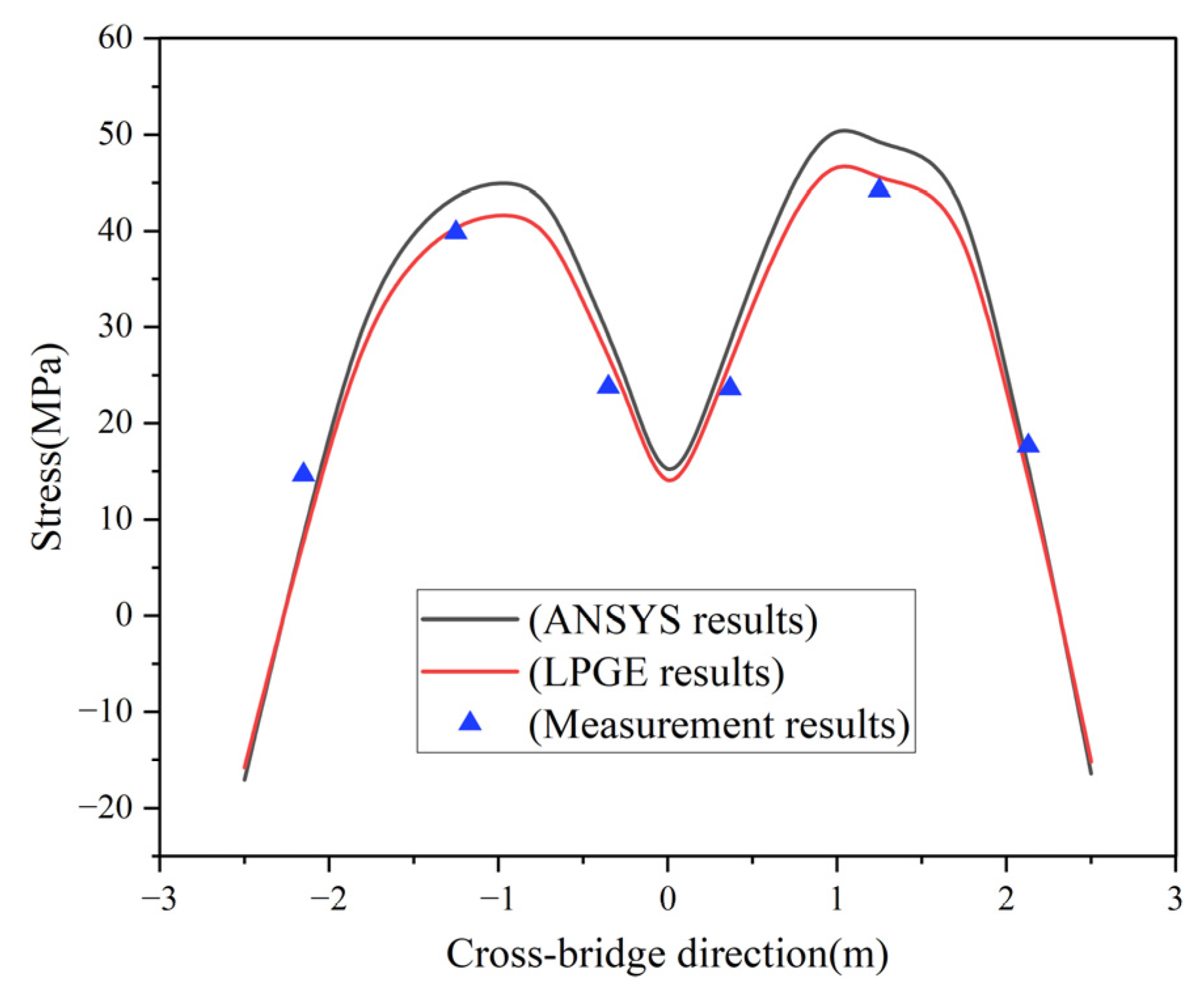

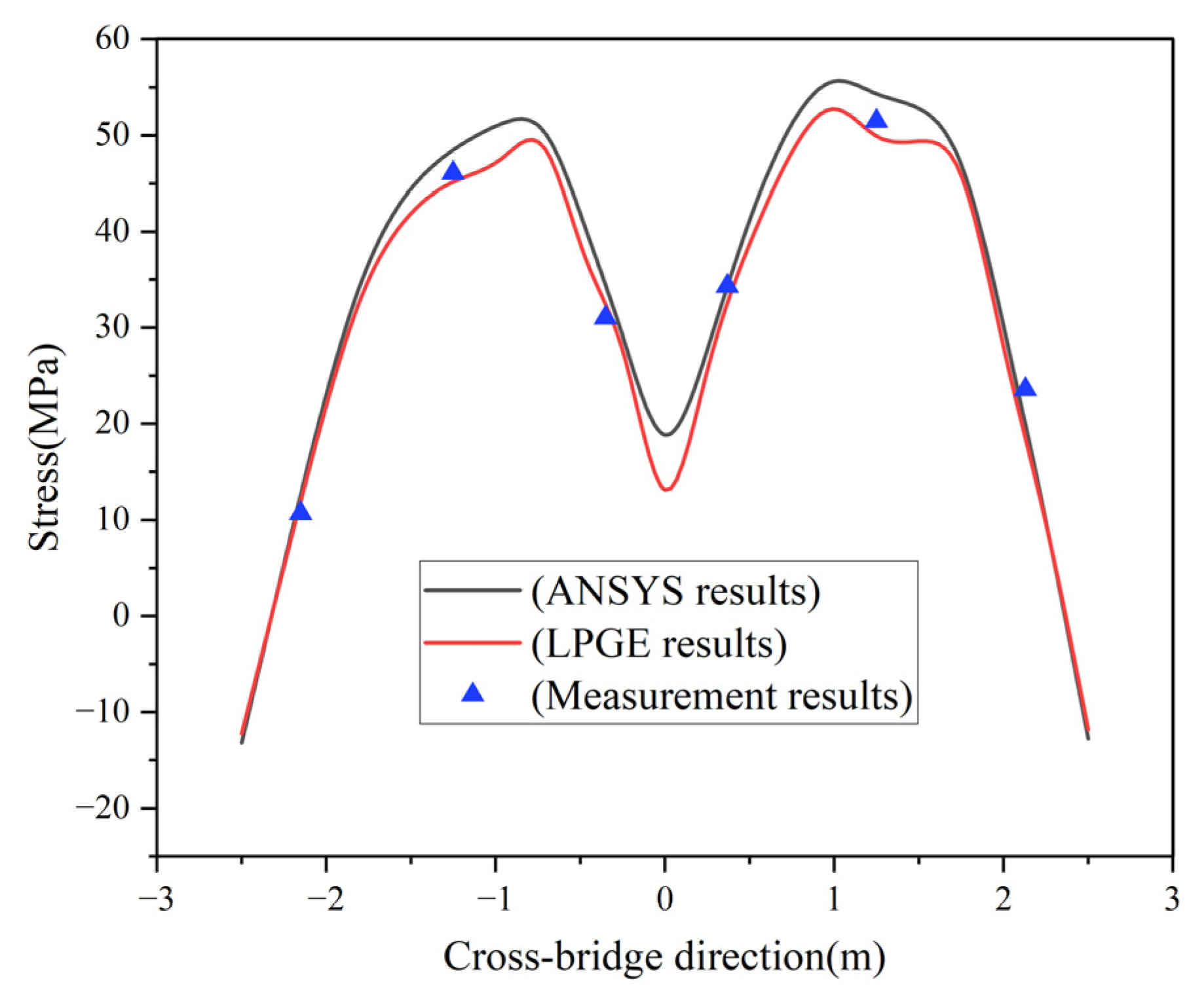
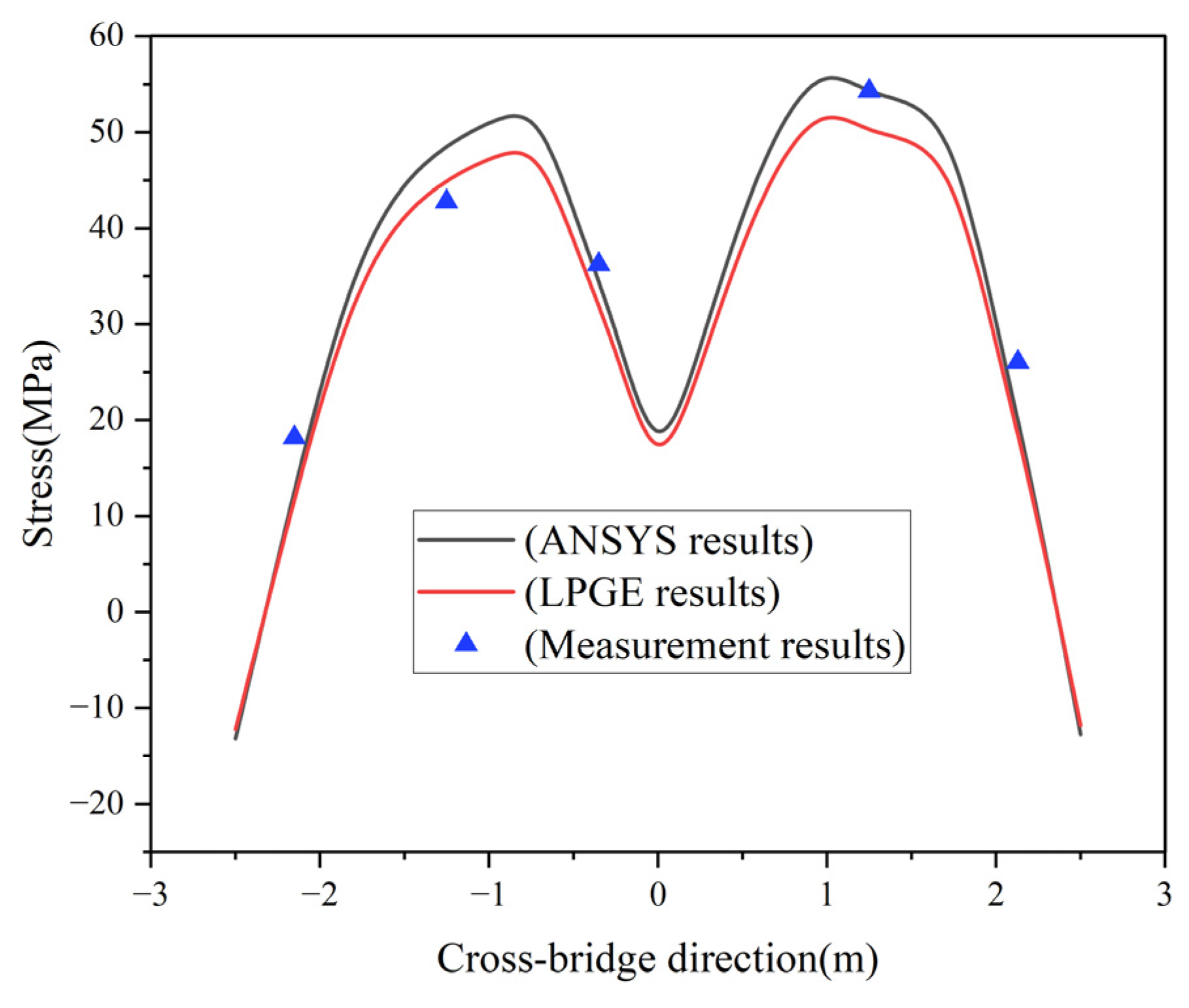


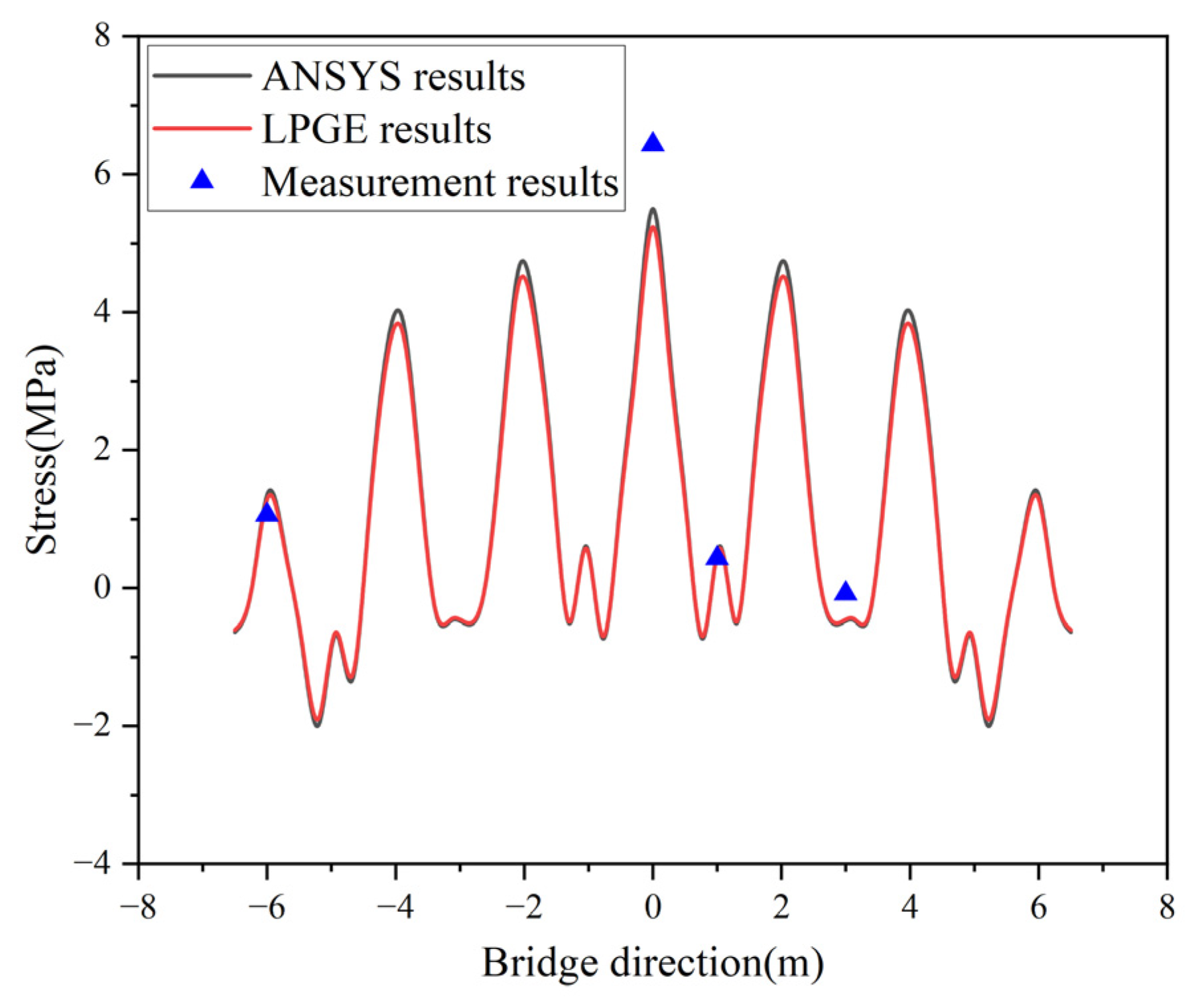
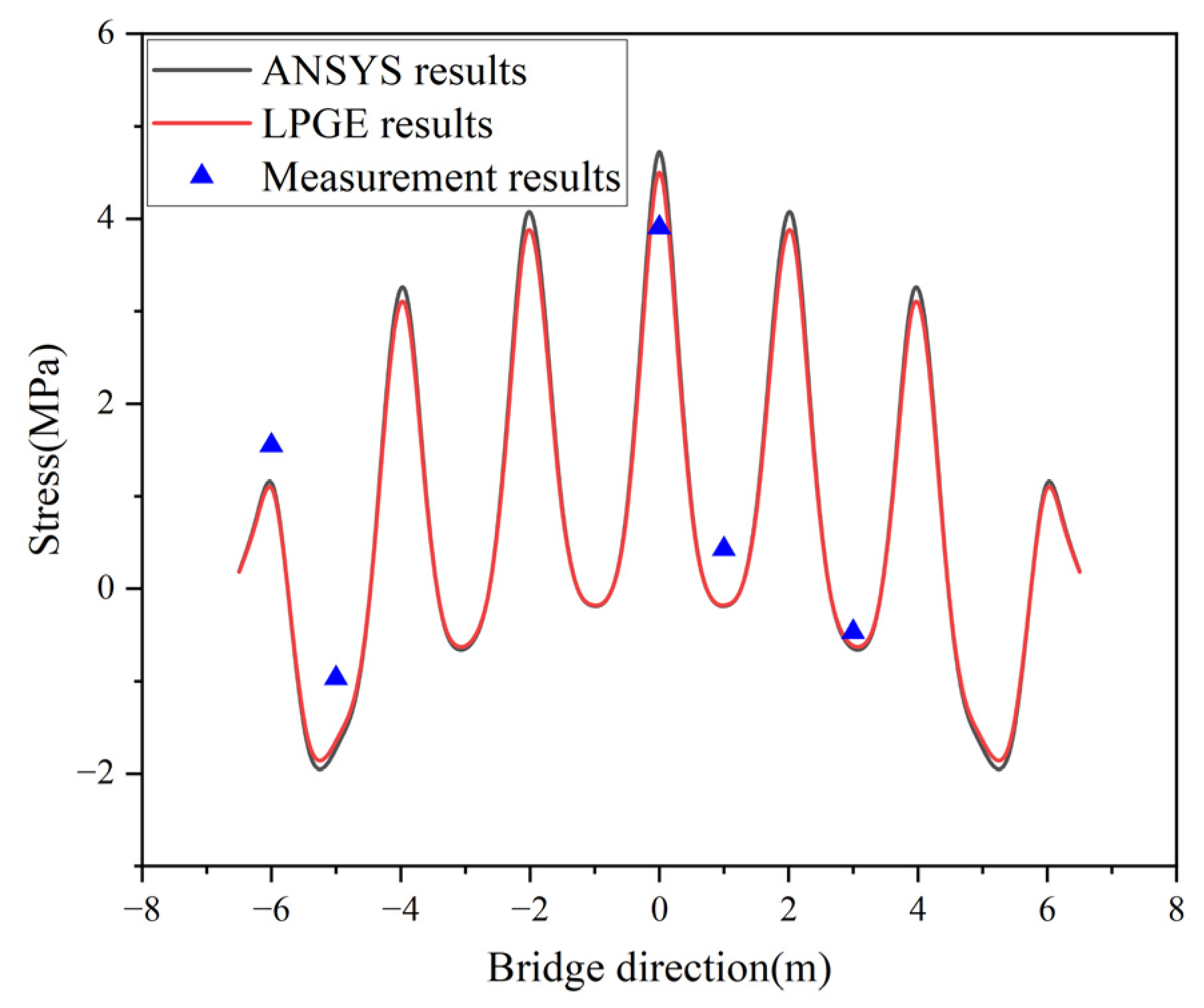
Disclaimer/Publisher’s Note: The statements, opinions and data contained in all publications are solely those of the individual author(s) and contributor(s) and not of MDPI and/or the editor(s). MDPI and/or the editor(s) disclaim responsibility for any injury to people or property resulting from any ideas, methods, instructions or products referred to in the content. |
© 2023 by the authors. Licensee MDPI, Basel, Switzerland. This article is an open access article distributed under the terms and conditions of the Creative Commons Attribution (CC BY) license (https://creativecommons.org/licenses/by/4.0/).
Share and Cite
Han, Y.; Chen, L.; Hou, W. Study of a Layered Plate Girder Element of Composite Materials and Its Applications. Appl. Sci. 2023, 13, 6545. https://doi.org/10.3390/app13116545
Han Y, Chen L, Hou W. Study of a Layered Plate Girder Element of Composite Materials and Its Applications. Applied Sciences. 2023; 13(11):6545. https://doi.org/10.3390/app13116545
Chicago/Turabian StyleHan, Yanqun, Li Chen, and Wenqi Hou. 2023. "Study of a Layered Plate Girder Element of Composite Materials and Its Applications" Applied Sciences 13, no. 11: 6545. https://doi.org/10.3390/app13116545




